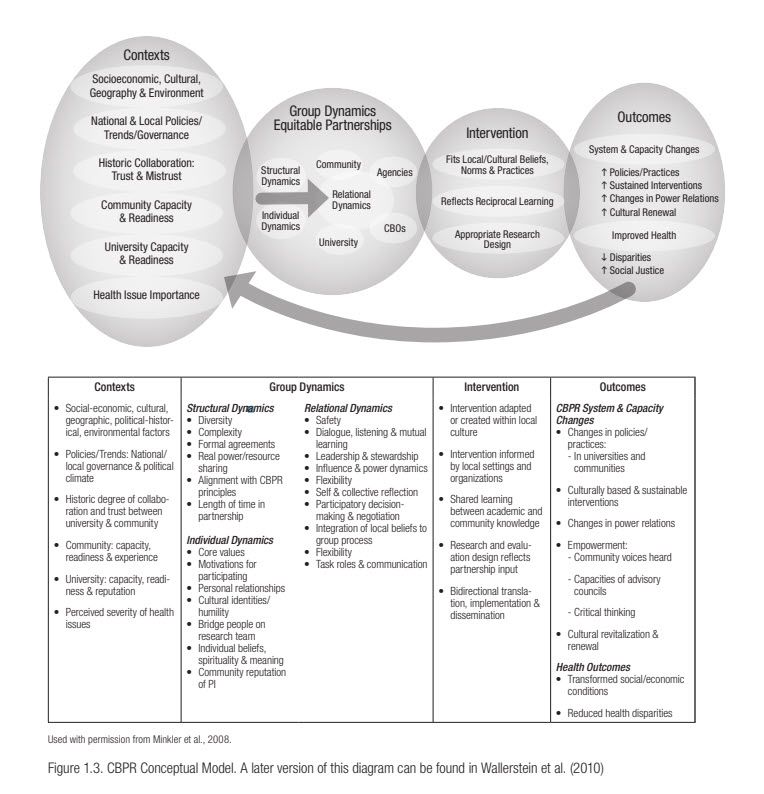What to know
The literature provides models and frameworks for understanding health promotion and health research that can be helpful in the practice of community engagement. We cover a number of those here.
Section Overview
This concept contextualizes health to be affected by the interaction between the individual, the group/community, and physical, social, and political environments. Both the community engagement approach and the SEM recognize the complex role played by context in the development of health problems. It also plays a role in the success or failure of attempts to address these problems. Grounded in social ecological theory, CDC created a four-level model of the factors affecting health. The four levels include:
- Individual
- Relationship
- Community
- Societal
Health professionals, researchers, and community leaders can use this model to identify factors at different levels that contribute to poor health. Knowing these factors can inform multi-level approaches to address health and reinforce change.
The Active Community Engagement (ACE) continuum provides a framework for analyzing community engagement. It also considers the role community plays in influencing lasting behavior change. This framework was developed by the Access, Quality and Use in Reproductive Health (ACQUIRE) project team and their supporting partners. The ACE continuum is based on a review of documents, best practices, and lessons learned during the ACQUIRE project. In a paper by Russell et al. (2008) the continuum is described as follows:
Definition of a Continuum
The experience of the ACQUIRE team shows that community engagement is not a one-time event but rather an evolutionary process. At each successive level of engagement, community members move closer to being change agents themselves rather than targets for change. Collaboration increases, as does community empowerment. At the final (collaborative) level, communities and stakeholders are represented equally in the partnership. All parties are mutually accountable for all aspects of the project.
Everett Rogers defined diffusion as:
"the process by which an innovation is communicated through certain channels over time among the members of a social system."
In the case of diffusion of innovation, the communication is about an idea or new approach. Understanding the diffusion process is essential to community-engaged efforts to spread innovative practices in health improvement. Rogers offered an early formulation of the idea that there are different stages in the innovation process. Individuals move through these stages at different rates and with different concerns. Rogers identified these stages as:
- Knowledge
- Persuasion
- Decision
- Implementation
- Confirmation
Rogers noted that the innovation process is influenced both by the individuals involved in the process and by the innovation itself. This model provides a platform for understanding variations in how communities (or groups/individuals within communities) respond to community engagement efforts.
Community-based participatory research (CBPR) is the most well-known framework for CEnR. In CBPR, all collaborators respect the strengths that each brings to the partnership. The community also participates fully in all aspects of the research process. Although CBPR begins with an important research topic, its aim is to achieve social change to:
- improve health outcomes and,
- eliminate health disparities.
The below conceptual model addresses four dimensions of CBPR and outlines the potential relationships between each. The authors identify:
"contextual factors” that shape the nature of the research and the partnership, and can determine whether and how a partnership is initiated. Next, group dynamics…interact with contextual factors to produce the intervention and its research design. Finally, intermediate system and capacity changes, and ultimately, health outcomes, result directly from the intervention research.
Models such as these are essential to efforts to empirically assess or evaluate community engagement practices and disseminate effective approaches.
NIH has created a new impetus toward participatory research through an increase in funding mechanisms that require participation. 'Translation' means turning research into practice by taking it from "the bench to the bedside and into the community."
Increasingly, community participation is recognized as necessary for translating existing research to implement and to:
- sustain new health promotion programs
- change clinical practice
- improve population health, and
- reduce health disparities.



